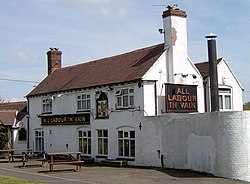Horsehay
| Horsehay | |
| Shropshire | |
|---|---|
 The All Labour in Vain, Horsehay | |
| Location | |
| Grid reference: | SJ675075 |
| Location: | 52°39’23"N, 2°29’27"W |
| Data | |
| Local Government | |
| Council: | Telford and Wrekin |
Horsehay is a village on the western outskirts of Dawley, which, along with several other towns and villages, now forms part of the new town of Telford in Shropshire. Horsehay lies in the Dawley Hamlets parish, and on the northern edge of the Ironbridge Gorge area.
The name of the village is from the Old English Hor hæg, meaning "Horse meadow". Its history as a village however is far more recent.
Horsehay used to have four pubs, The Station Inn, The Forester Arms, the All Labour In Vain and the Travellers Joy. The Station Inn closed down in 2012 and the All Labour in Vain soon after (not helped by its famous pub sign, showing local wenches laboring in vain, scrubbing a black boy in a tub, which had attracted adverse comment, if not from local folk). The village has a Methodist Chapel, a village hall and a post office. Horsehay also has its very own golf course golf course, complete with restaurant.
History
Horsehay was nothing more than a farm until the 1750s when Abraham Darby II built a blast furnace next to what is now known as Horsehay Pool. The Coalbrookdale Company further developed the area, constructing brickworks and later a pottery in 1838. Coalbrookdale specialised in the smaller and more decorative ironwork pieces, whereas Horsehay produced many larger scale products, including the railway bridge in nearby Shifnal. As the iron trade in the area began to slump, in 1857 the railway arrived; it closed in the 20th century, but part of the track is preserved in operation as the Telford Steam Railway.
A.B. Cranes bought the site previously occupied by the ironworks to manufacture some of the largest cranes in Europe until it closed down in 1983. The site has been transformed into both a small factory estate and a housing estate. The houses which were kept for the ironworks employees were clustered around Horsehay Pool in Spring Village, and they are still lived in today.
Horsehay Works
Horsehay works has a history of more than 230 years on the same site. Formed in 1755 by Abraham Darby II it contributed to the birth of the industrial revolution through large scale production of iron. Later it produced pre-fabricated bridges for export all over the world. It was a major employer in the area until the mid-1980s when it closed under the ownership of Adamson Alliance.
Colebrookdale's Industrial Revolution began with the success of Abraham Darby I in 1709 smelting iron with coke. When his son, Abraham Darby II, came of age and assumed management, the Coalbrookdale Company expanded quickly and needed additional furnaces. Horsehay, an easy walk to the north, provided a sufficient water supply and land for lease, while Dawley to the east provided coal, and so Darby established the Horsehay Works. The furnace at Horsehay came into blast successfully on 5 May 1755.
The new furnace ushered in a period of great activity when the East Shropshire Coalfield, for a time, became the area of greatest production of iron then known. Such was the importance of the furnace that many people including dignitaries visited it.[1]
A railway from Horsehay to the nearby Severn wharves was built and the first waggon of 'pigs' (iron) was sent down Jiggers bank through Coalbrookdale and on to the wharves almost within sight of the Ironbridge (built later by Abraham Darby III, completed in 1779).
Telford Horsehay Steam Trust
Horsehay is home to the Telford Steam Railway. It holds various events throughout the year, including 'Day Out With Thomas', where at Christmas children get the chance to ride on a train hauled by Thomas the Tank Engine to see Santa.
Outside links
| ("Wikimedia Commons" has material about Horsehay) |
References
- ↑ "Horsehay Works (1755 - 1986) - a history of a once dominating company" by J. L. Woolley
- Horsehay – P Heath